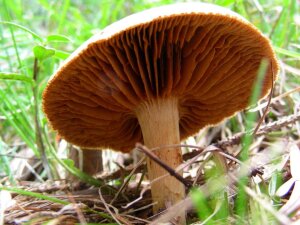
- Life
Published: | By: Ute Schönfelder
Source article
What proves to be advantageous will be preserved in the long term. Put in very simple terms, this is the principle of evolution whereby organisms adapt to an environment in the best possible way. These adaptation processes often result in similar or the same traits in different groups of organisms, if their environment requires it. The streamlined body shape of fish and marine mammals, e.g. dolphins, is due to such ‘convergent evolution’. Many other examples of convergent evolution can be found at the level of molecules or the metabolism.
A team of researchers from the Institute of Pharmacy at the University of Jena and the Leibniz Institute for Natural Product Research and Infection Biology — Hans Knöll Institute, together with their colleagues from the University of Freiburg, have discovered a new, hitherto unknown example of convergent evolution in the mushrooms genus Cortinarius (the webcaps). The researchers found out that the mushrooms produce certain natural products called ‘anthraquinones’, and that they have developed their own metabolic pathway for doing so. The team of mycologist Prof. Dr Dirk Hoffmeister of the University of Jena publishes its results in the current edition of the renowned scientific journal Angewandte Chemie International Edition.
Cortinarius
mushrooms synthesize a variety of natural products
‘Cortinarius is one of the most diverse genera of mushrooms,’ Dirk Hoffmeister says. There are around 2000 species described worldwide, and about 500 species in Central Europe alone. ‘In autumn, we can find numerous species of the Cortinarius mushrooms with their strikingly colourful fruiting bodies in Central Germany, too,’ Hoffmeister continues. However, mushroom pickers find the Cortinarius mushrooms less interesting, since most species are inedible, several are poisonous, and some even lethal.
Mushroom expert Hoffmeister puts the reason for that in a nutshell: ‘Cortinarius mushrooms are extraordinary chemists.’ They synthesize a variety of natural products, including anthraquinones. ‘These are vividly coloured and often toxic chemical compounds of which the mushrooms produce a great diversity,’ Hoffmeister explains.
Six new genes for enzymes found in the
Bacteria, plants and moulds can also synthesize anthraquinones and have developed different metabolic pathways for this. Dirk Hoffmeister and his team have examined how the species Cortinarius odorifer synthesizes anthraquinones. For this purpose, they searched the mushroom’s genome for genes encoding enzymes used by other fungi to produce the chemical compounds from which the anthraquinones originate. ‘We were very surprised by the fact that we did not find the genes we were looking for,’ Dirk Hoffmeister says. Instead, the researchers discovered genes for hitherto unknown enzymes that are also able to catalyse the synthesis of anthraquinone precursors.
By transferring the newly detected genes from the Cortinarius to a mould genus, the researchers were able to prove that they had discovered a new metabolic pathway. Equipped with these new genes, the moulds displayed the same enzyme activity as the Cortinarius mushrooms and consequently became coloured.
The reason for the development of a separate metabolic pathway in the evolution of Cortinarius mushrooms is yet to be found. According to Hoffmeister, ‘these very different groups of organisms must have been under great evolutionary pressure to have learned to produce anthraquinones completely independently of each other and in different ways.’
Original Publication:
Löhr N.A. et al. Unprecedented Mushroom Polyketide Synthases Produce the Universal Anthraquinone Precursor, Angew. Chem. Int. Ed. 2022, e202116142, https://doi.org/10.1002/anie.202116142External link
